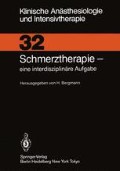Zusammenfassung
Der akute Schmerz hat eine lebenserhaltende Bedeutung: Schädliche Einflüsse von außen und innen werden erkannt und durch geeignete Reaktionen abgestellt. Dem chronischen Schmerz fehlt diese Warnfunktion. Er kann zum Dauerleiden werden, zur Schmerzkrankheit. Die Behandlung des chronischen Schmerzes ist deshalb eine vordringliche ärztliche Pflicht. Wenn eine kurative Therapie nicht möglich ist, müssen palliative Maßnahmen zur Schmerzbeseitigung eingesetzt werden. Der nachfolgende Beitrag erörtert einige periphere und zentralnervöse Mechanismen des Schmerzes und seiner Behandlung. Für den interessierten Leser gibt es eine Reihe ausführlicher Übersichten (3, 9, 18, 24, 25, 30, 33, 34).
Access this chapter
Tax calculation will be finalised at checkout
Purchases are for personal use only
Preview
Unable to display preview. Download preview PDF.
Literatur
APPENZELLER, O.: Somatoautonomic reflexology — normal and abnormal. In: The neurobiologic mechanisms in manipulative therapy (ed. I. M. KORR ), p. 179. New York, London: Plenum Press 1978
BLUMBERG, H., JÄNIG, W.: Neurophysiological analysis of efferent sympathetic and afferent fibers in skin nerves with experimentally produced neuromata. In: Phantom and stump pain (eds. J. SIEGFRIED, M. ZIMMERMANN ), p. 15. Berlin, Heidelberg, New York: Springer 1981
BONICA, J. J., LINDBLOM, U., IGGO, A.: Advances in pain research and therapy, vol. 5. New York: Raven Press 1983
CARSTENS, E., KLUMPP, D., ZIMMERMANN, M.: Differential inhibitory effects of medial and lateral midbrain Stimulation on spinal neuronal discharges to noxious skin heating in the cat. J. Neurophysiol. 43, 332 (1980)
CHAHL, L. A., SZOLCSANYI, J., LEMBECK, F.: Antidromic vasodilatation and neurogenic inflammation. Budapest: Adademiai Kiado 1984
CROOK, D., COLLINS, A. J., BACON, P. A., CHAN, R.: Effect of “aspirin-like” drug therapy. Prostaglandin synthetase activity from human rheumatoid synovial microsomes. Ann. rheum. Dis. 35, 327 (1976)
DEVOR, M.: The pathophysiology and anatomy of damaged nerve. In: Textbook of pain (eds. P. D. WALL, R. MELZACK ), p. 49. Edinburgh, London, Melbourne, New York: Churchill Living-stone 1984
DICKHAUS, H., PAUSER, G., ZIMMERMANN, M.: Hemmung im Rückenmark, ein neurophysiologischer Wirkungsmechanismus bei der Hypalgesie durch Stimulationsakupunktur. Wien, klin. Wschr. 90, 59 (1978)
GOTTSCHALDT, K.-M.: Neurale Grundlagen des Schmerzes. In: Aktuelle Probleme der Neuropsychiatrie (eds. M. GOTTSCHALDT, H. GRASS, M. BROCK), p. 47. Berlin, Heidelberg, New York: Springer 19 78
GROSS, D.: Sympathalgien des Nacken-Schulter-Arm-Bereiches. In: Nacken-Schulter-Arm-Syndrom (eds. R. KOCHER, D. GROSS, H. E. KAESER ), p. 49. Stuttgart, New York: Fischer 1980
GYBELS, J.: Analgesie brain Stimulation in chronic pain in man and rat. In: Current topics in pain research and therapy (eds. T. YOKOTA, R. DUBNER ), p. 137. Oxford, Princeton: Excerpta Medica 1983
HANDWERKER, H. O., ZIMMERMANN, M.: Schmerz und vegetatives Nervensystem. In: Klinische Pathologie des vegetativen Nervensystems (eds. A. STURM, W. BIRKMAYER ), p. 468. Stuttgart, New York: Fischer 1976
HANSEN, K., SCHLIACK, H.: Segmentale Innervation. Stuttgart: Thieme 1962
HERZ, A.: Endorphine und Schmerz. In: Schmerz (eds. W. KEESER, E. PÖPPEL, P. MITTERHUSEN ), p. 69. München, Wien, Baltimore: Urban & Schwarzenberg 1982
IRRMANN, M.: Zervixfaktor und Reflextherapie. In: Der Geburtsschmerz und seine Beeinflussung — Alternativen zu pharmakologischen Methoden (ed. H. WEIDINGER ), p. 73. Friedrichsdorf/Taunus: Milupa 1981
JÄNIG, W.: Das vegetative Nervensystem. In: Physiologie des Menschen, 20. Auflage (eds. R. F. SCHMIDT, G. THEWS ), p. 119. Berlin, Heidelberg, New York: Springer 1980
JÄNIG, W.: Viszeraler Schmerz — Sympathisches Nervensystem und Schmerz. Diagnostik J 15, 1 123 (1982)
KOSTERLITZ, H. W., TERENIUS, L. Y.: Pain and society. Weinheim, Deerfield Beach/Florida, Basel: Verlag Chemie 1980
LANKFORD, L. L.: Reflex sympathetic dystrophy. In: Management of peripheral nerve problems (eds. G. E. OMER, M. SPINNER ), p. 216. Philadelphia: Saunders 1980
LEMBECK, F., GAMSE, R.: Substance P in peripheral sensory processes. In: Substance P in the nervous system. Ciba Foundation symposium 91 (eds. R. PORTER, M. O’CONNOR), p. 35. London: Pitman 1982
MENSE, S.: Sensitization of group IV muscle receptors to bradykinin by 5-hydroxytryptamine and Prostaglandin E2. Brain Res. 225, 95 (1981)
REYNOLDS, D. V.: Surgery in the rat during electrical analgesia induced by focal brain Stimulation. Science 164, 444 (1969)
SATO, A.: Physiological studies of the somatoautonomic reflexes. In: Modern developments in the principles and practice of chiropractic (ed. S. HALDEMAN ), p. 93. Appleton- Century-Crofts, Prentice Hall 1980
SCHMIDT, R. F.: Grundriß der Sinnesphysiologie, 4. Auflage. Heidelberger Taschenbücher, Band 136. Berlin, Heidelberg, New York: Springer 1982
SCHMIDT, R. F., STRUPPLER, A.: Der Schmerz. München: Piper 1982
SZÜCS, A., CSILLIK, B., KNYIHAR-CSILLIK, E.: Treatment of terminal pain in cancer patients by means of iontophoresis of vinca alkaloids. In: Pain in the cancer patient (eds. M. ZIMMERMANN, P. DRINGS, G. WAGNER ), p. 185. Berlin, Hei¬delberg, New York, Tokyo: Springer 1984
THOENEN, H., KREUTZBERG, G. W.: The role of fast transport in the nervous system. Neurosci. Res. Program Bull. 20, No. 1 (1981)
TROSTDORF, E.: Die Kausalgie. Stuttgart: Thieme 1956
TURNER, R.: Clinical pharmacology and therapeutics. London: Macmillan Publishers 1980
WALL, P. D., MELZACK, R.: Textbook of pain. Edinburgh, London, Melbourne, New York: Churchill Livingstone 1984
ZENZ, M.: Peridurale Opiat-Analgesie. Stuttgart, New York: Fischer 1981
ZIMMERMANN, M.: Peripheral and central nervous mechanisms of nociception, pain, and pain therapy: facts and hypotheses. In: Advances in pain research and therapy (eds. J. J. BONICA, J. C. LIEBESKIND, D. G. ALBE-FESSARD), vol. 3, p. 3. New York Raven Press 19 79
ZIMMERMANN, M.: Sornato-viscerale Sensibilität: die Verarbeitung im Zentralnervensystem. In: Physiologie des Menschen, 20. Auflage (eds. R. F. SCHMIDT, G. THEWS ), p. 209. Berlin, Heidelberg, New York: Springer 1980
ZIMMERMANN, M., HANDWERKER, H. O.: Schmerz, Konzepte und ärztliches Handeln. Berlin, Heidelberg, New York, Tokyo: Springer 1984
ZIMMERMANN, M., LONG, D. M.: Antipyretic analgesic therapy. Current worldwide status. Amer. J. Med. 75, 1 (1983)
Editor information
Editors and Affiliations
Rights and permissions
Copyright information
© 1986 Springer-Verlag Berlin · Heidelberg
About this chapter
Cite this chapter
Zimmermann, M. (1986). Physiologische Mechanismen des Schmerzes und seiner Behandlung. In: Bergmann, H. (eds) Schmerztherapie. Klinische Anästhesiologie und Intensivtherapie, vol 32. Springer, Berlin, Heidelberg. https://doi.org/10.1007/978-3-642-71333-0_1
Download citation
DOI: https://doi.org/10.1007/978-3-642-71333-0_1
Publisher Name: Springer, Berlin, Heidelberg
Print ISBN: 978-3-540-16698-6
Online ISBN: 978-3-642-71333-0
eBook Packages: Springer Book Archive

